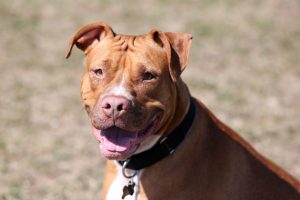
You might be one of those anxious parents that wants to know whether their child, or in this case, dog is doing okay, and whether they are developing as they should. It is quite commendable that you are taking a keen interest in what your puppy should be going through. In any case, there is no better way to raise a pup than to first gather all the information you need to do the job right.
And that’s exactly what you are looking for, information that will help inform whether your new woof box is hitting the growth milestones as it is supposed to. This article is meant to be a rough guide on what to expect. This is because all the pit bulls might look the same, the different individuals in the breed will develop at slightly different rates.
In the Beginning…
There was light, and it seemed to radiate off of this beautiful puppy that for some reason, just cannot stop attempting to chew your fingers, even though they have no teeth. Yes, your puppy is physically small and in just a matter of weeks, it will have grown into something capable of accompanying you on your evening jogs.
In a similar way to how human children grow, the bones of your puppy are what will experience the most growth in the early stages of growing. During this time, the surrounding tissue will continue growing and being flexible enough to match the rapid growth of the bones.
This period of bone growth will be within the first 18 to 24 months of the puppy’s life. At this age, the bones will now begin to properly harden to become adult bone. This period of growth is absolutely crucial to the growth and development of the puppy, and it is one reason why it is advised not to put your pup through vigorous or strenuous activity.
These activities include, but are not limited to, jumping from elevated places or pulling heavy loads. This is because the growth of a puppy begins in growth plates, and it is these plates that get molded into the final structure to hold the pup.
If you are also looking to use the female to start your own breeding line, then it would be best to wait until they reach two years before allowing them to get pregnant. Dogs can reach sexual maturity as early as nine months of age, but this can end up being detrimental to their growth and development as their bone structure will not have fully developed.

Pit bulls and their various sizes.
From what you may have already seen, you have a general idea of the size of dog that a pit bull can grow up to be. The medium size dog is what most people are used to, but they are not limited to this.
The term pit bull is mostly used to describe four different, but closely related, breeds of dog. From these four, there are various other cross breeds that have resulted in dogs such as bully pits or the pocket pit bull. These however, are on the smaller side of the scale.
On the other side, you may have come across a famous pit bull known as Hulk. Pit bulls of such pedigree can reach weights of up to 170 pounds.
There are various things that will determine the size your pit bull will reach when it hits final form.
- The Breed.
As mentioned earlier, the term pit bull can be used for a variety of dogs, both pure and cross bred. If you got your puppy from a shelter, it is likely they may be cross bred. If you got one from a breeder, you have its entire history, and you know what to expect from it.
- The sex.
Nature isn’t always standard. With some animals, the females can be larger than the males, and vice versa in others. Dogs are definitely in the vice versa group. The standard female pit bull that has reached maturity will weigh anywhere from 30 to 50 pounds. They will usually reach up to 20 inches in height.
In comparison, the males will be heavier, and they can weigh in at a range o 35 to 60 pounds. There won’t be that much difference in height as they will usually start at 21 inches.
When the pit bull gets to 18 to 24 months, their bone structure would have reached its final point of development, and you will have yourself a lanky pit bull that in all essence resembles a human teenager. At this point, growth stops, and development sets in.
To get the characteristic stocky looks, the structure will now start to fill out as the pup builds muscles. You will notice changes in weight but this shouldn’t alarm you too much. By age three, the dog will have achieved final form, and you can declare it to be a properly raised pit bull.

Things that can affect your pit bull’s growth.
Unlike a commercial building that will achieve the targets set for it on paper, your dog is a living organism. That means that a lot of things could determine whether it achieves the form it was supposed to, whether it will be under, or whether it will be over the recommendations. Here are some…
- Nutrition.
As with a human, the quality of food that your pup receives will determine what kind of dog it will turn out to be. During the growth phase, it would be best to provide your pup with a lot of vitamins, minerals and calories to help support proper growth, as well as help them maintain their playful energy. It is a terrier, so zooming around will be a common occurrence.
The most important nutrient though will be proteins. Your dog will need proteins to help build muscle, and to help repair and grow new cells. This will make it easier for them to recover from any injuries they may pick up during their play time.
- The Genes.
The pit bull is one breed that has undergone various modifications over the years to achieve desired effects. This makes it terrible to try and predict what size it will grow to be. This is especially true if you have no idea what its parents look like.
Your specific pup could be a result of interbreeding between the pit bull breeds, or even another larger breed was introduced somewhere along its lineage.
- Juvenile injuries.
The growth plates of a pup are essential to it achieving the form it is meant to achieve as an adult. Any change to the structure of these plates and there is a high risk that your pup will experience stunted growth, or even carry the injury into adulthood. This can have the effect of reducing its quality of life.
So, while carefully raising one, ensure it doesn’t develop a knack of jumping from high places. This is the easiest way that your pup can end up getting injured.
- Disease.
If your pup does develop a serious infection, the body of the pup might divert resources to help it fight off the infection. These could end up affecting the development of the pup and the outcome several months later. This is why it is crucial to vaccinate your pup and have regular visits to the vet.








